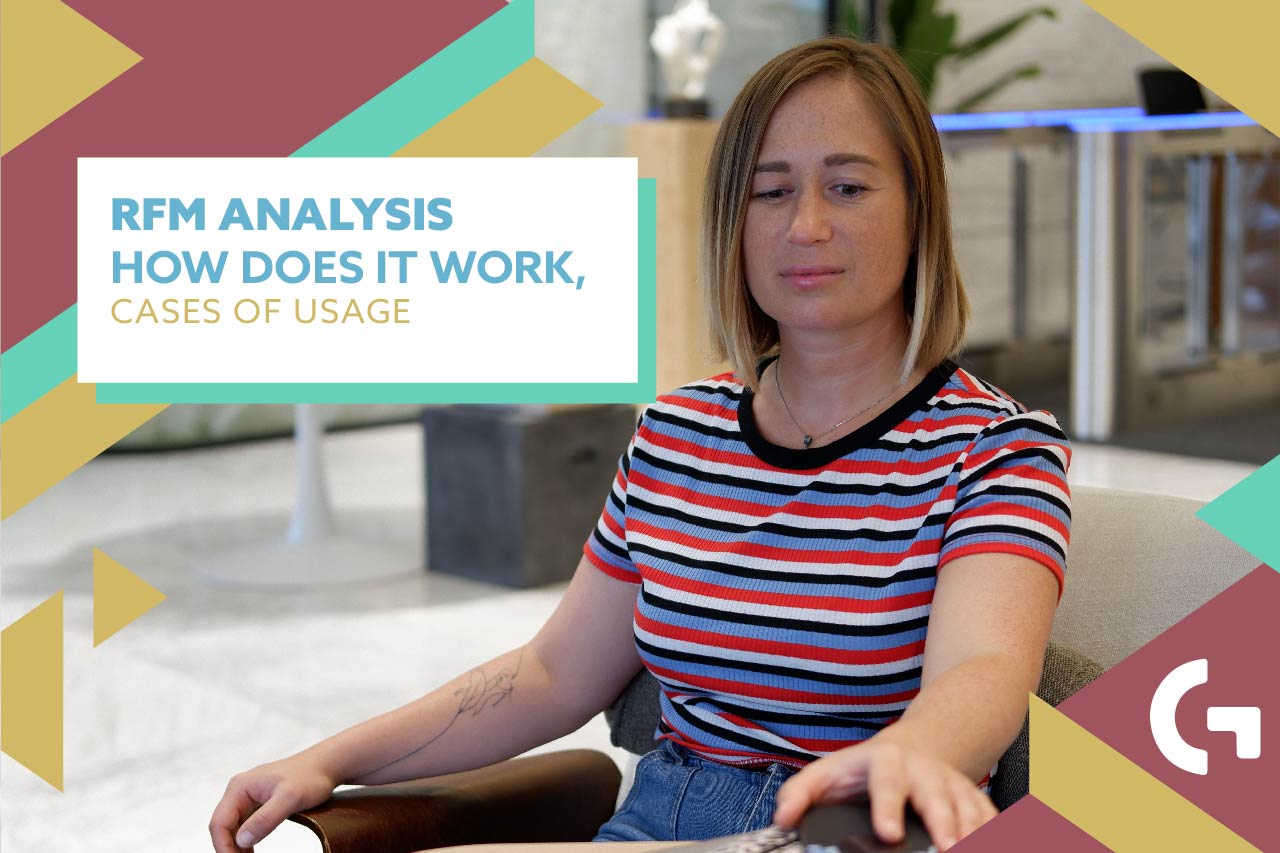RFM analysis – how does it work, cases of usage

RFM analysis is a marketing tool used to identify a company’s best clients based on their spending habits. In this article I would like to give you a profound understanding of how it works, in what cases you need to use it and what goals RFM can help you reach.
Content
- What do letters in RFM stand for?
- RFM analysis for customer segmentation
- What aims RFM analysis can help you reach?
- How to perform an RFM analysis?
What do letters in RFM stand for?
Recency
Recency value focuses on how recent a customer’s last interaction was with a brand. It specifically looks at their last purchase, the last visit to the company’s website, the last time they used a mobile app, liked or commented on a post on social media, or the last transaction they performed.
Above all, recency is one of the key metrics used in the RFM analysis to create an RFM segmentation. It measures how recently a customer interacted with a company via social media, website, or other touchpoints to identify high-value customers.
Marketers use this information to determine or predict the likelihood of a customer to respond to more marketing messages in the future. Therefore, recency value believes that the more recent a customer’s purchase was, the more responsive they are to new product promotions.
Marketers ask questions like how much time has elapsed since a customer’s last activity or transaction with the brand to assign a recency score.
Frequency
Frequency value focuses on the number of times a customer made a purchase or interacted with a company within a specific period.
It is an RFM metric that shows how deeply connected or engaged a customer is with your brand. Marketers ask questions like how often or frequently a customer transacted or interacted with the company during a particular period to assign a frequency score.
The frequency metric believes that customers who frequently interact or engage with a brand (repeat customers) are more likely to be more loyal customers than other customers who don’t interact with the company.
Under frequency, one-time customers (customers who make a purchase once) are grouped into different customer segments. Like recency value, Frequency value also aids the creation of RFM segmentation.
Monetary
Monetary value is the total amount of money a customer has spent purchasing products or services from a company over a particular time.
It is one of the RFM metrics used to identify and create RFM segments for customers who have spent the most money – big spenders, in the past and are more likely to spend more money on products or services in the future.
Aside from this, it also helps marketers to differentiate and target customers based on their monetary value (amount of money they spend or have spent). The idea of the monetary value is that big spenders should be treated differently than customers who spend less.
Essentially, RFM analysis works by measuring the recency, frequency, and monetary value of customers to determine the best customers by their RFM score.
We have created an RFM analysis report template that you can find and purchase in our store. Check it out by the link.
RFM analysis for customer segmentation
By using a RFM scoring system such as this you can construct an effective marketing strategy by creating customer RFM segments, including:
Your best customers
These are the customers who earn top scores in every category. They’re loyal, willing to spend generously and likely to make another purchase soon. Such customers are primed to respond well to loyalty programs. They’re more likely to be interested in new products you launch. And because they’re committed to your brand and its products, it probably makes less business sense to offer them discount pricing. Instead, increase CLTV by suggesting big-ticket items and recommending products based on past purchases.
Your big spenders
This customer segment is based on only one of the three metrics: customers with top scores for monetary value. Typically, marketers target this segment with luxury offers, higher subscription tiers and value-add cross-/upsells that increase average order value. Again, it probably makes sense not to shrink margins by offering discounts.
Your loyal customers
This is another customer segment that takes into consideration only one of the three metrics: customers with top scores for frequency. Despite making purchases often, they aren’t necessarily your biggest spenders, so consider rewarding them with free shipping or similar offers. Advocacy programs and reviews can also be effective ways to engage these customers.
Your faithful customers
Customers who score high for frequency but low in monetary value tend to respond best to product recommendations based on past purchases, as well as incentives tied to spending thresholds (e.g., a free gift for transactions above the brand’s average order value).
Your at-risk customers
Customers who have been in your top tier in the past (best, big spenders and/or loyal) but who now score low for recency and frequency present a special opportunity. Marketers should consider targeting them with messages aimed at retention, such as discount pricing, exclusive offers and new product launches. With the help of your CDP, you can even create specific customer journeys aimed at re-engaging and retaining at-risk customers.
What aims RFM analysis can help you reach?
Aside from the above functions mentioned above, an RFM analysis can help you achieve the following:
1. Identify high-value customers
Certainly, if you are looking for a means to identify your best customers and target them with various special campaigns, RFM analysis offers you the best and the easiest approach to achieve this.
High-value customers are customers with the highest lifetime value and are most likely going to add the highest revenue to the company.
RFM analysis finds and analyzes the recency of purchase, frequency of purchase, and monetary value of a customer purchase to determine valuable customers and add them to a segment.
2. Identify the Top 20% and bottom 20% of customers
RFM analysis also helps you identify your best 20% of customers, including the top 10% who contribute the highest revenue to your company and the bottom 20% who contribute the lowest.
With an RFM model and analysis, marketers can develop a more effective strategy to retain the top customers and encourage the bottom 20% to purchase more products.
3. Increase personalization
The only reason you want to identify your best and worst customers is to develop the best strategy to maximize your revenue and increase your customer base.
Marketers can create personalized marketing messages and campaigns that are best suited for each customer segment.
4. Improve conversion rates
Conversion rates indicate the success of a marketing campaign.
When your customers get the content, messages, and promotion they care about, they are more likely to engage with it, thereby increasing their conversion rate.
5. Increase revenue and profits
It is pretty obvious that when you create the right content for the right customer segments, you increase their interest and engagement with your products or services to increase your chances of making more sales.
More sales and more customers mean more money for the company.
6. Increase customer loyalty
Good use of the information and insights generated from RFM analysis can help improve customer loyalty.
When the customer gets more promotions of the content they like, they are likely to stay and buy more from the company – making them more loyal to your brand.
How to perform an RFM analysis?
Basically, to perform an RFM analysis you need to follow the following steps:
- Gather relevant data
- Set up RFM scales
Consider using custom-built filters such as the amount spent, email subscription status, last order dates, number of orders, product subscription status, products purchased, customer added date, predicted spend tier, etc., to describe your customers’ recency, frequency, and monetary values.
- Assign RFM scores to the customers
RFM score is a numerical score that helps you to determine the value or rank of your customers, from the best to the worst. The RFM value of each customer ranges from 1 – 5 point score, and you assign these to the customer based on their RFM value within a period.
- Classify customers into segments
- Personalize strategies for the customer segments that are most relevant to you
Moreover, if you want to see an example of RFM analysis and data visualization in Google Data Studio, check out this article in my blog.
***
In our template store, we have a report template for RFM analysis for Customer Segmentation. Our presettings will save you a plenty of time running the analysis. You will have a ready-to-use report in only 5-10 minutes!
Share your experience of performing RFM analysis in the comments section! Was it easy for you? If not, what challenges have you faced?
